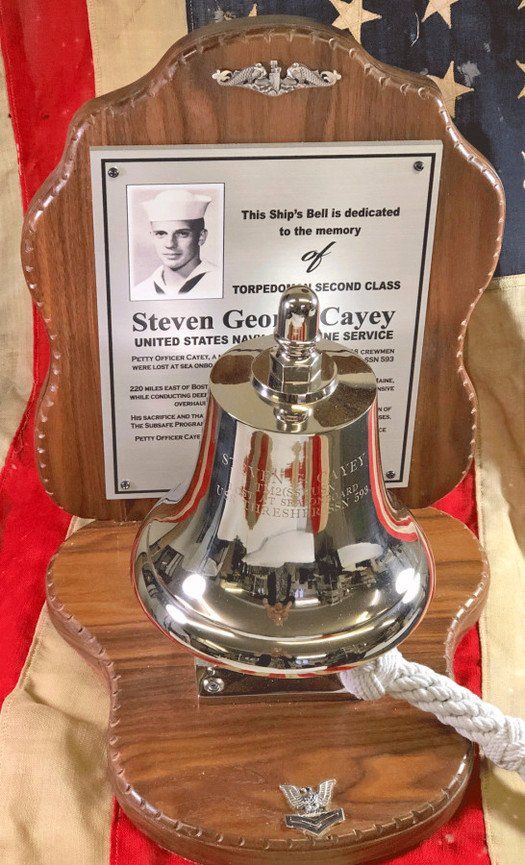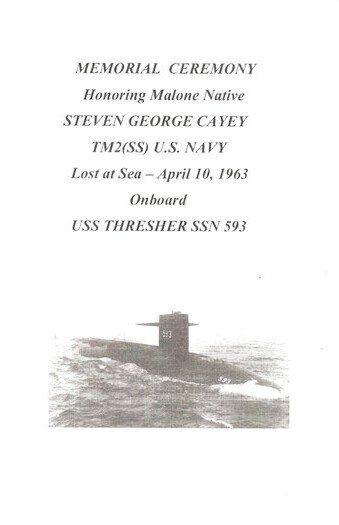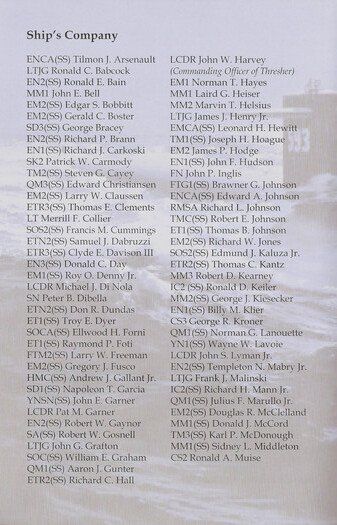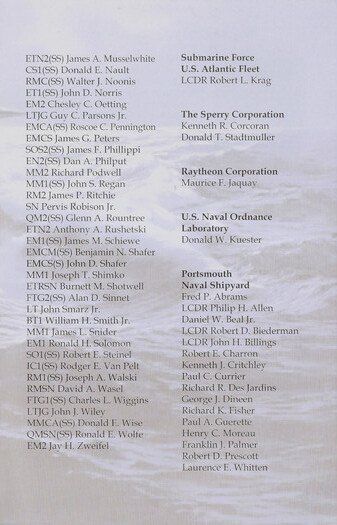Steven Cayey Exhibit

The Loss of Thresher
On April 10, 1963, the nuclear submarine USS Thresher (SSN 593) was lost at sea, 220 miles from Boston, with 129 men aboard. Commissioned in 1961, Thresher was the deepest diving, fastest, and most silent submarine ever built. After nine months in the shipyard of Portsmouth, NH, Thresher had gone out to sea on April 9 for two days of deep diving tests. Having ascertained the submarine’s seaworthiness at shallow depths, the ship proceeded to descend to her test depth of 1,300 feet.
The submarine was last heard from at 9:17 AM on April 10 with the words, "Approaching test depth." Thresher’s accompanying rescue ship Skylark was unable to establish any more telephone contact. At 9:18 AM, Skylark’s sonar detected sounds of a submarine breaking apart. By nightfall, a rescue ship had found an oil slick, some gloves, and bits of cork and insulation near Thresher’s last known location--conclusive signs of a lost ship.
It is thought that the disaster was caused by failure of the ship’s saltwater pumping system, which led to a shutdown of the nuclear reactor. Loss of propulsion and malfunction of the ballast tanks led to
Thresher’s sinking.


Thresher Memorialized
Memorial services have been held throughout the United States in small towns and large cities alike, on April 10 of every year since Thresher’s loss. On April 10, 2019, such a service was held for the first time at the AMVETS Post #8 in Malone, NY. The ceremony honored the memory of Steven George Cayey, a native son of Malone and Potsdam, who was lost aboard Thresher.
Frank Dorchak, Jr., a former submariner and present historian of the American Legion Post of Malone, discovered that Steven had never been formally memorialized in Malone or Potsdam. Frank had been assigned to
Thresher’s crew just before her test dive, but was pulled at the last minute for service elsewhere. He therefore has always held
Thresher’s memory close to his heart. Steven’s sister, Diane Cayey Anderson, was able to contact Frank in February 2019, and plans for an April 10 ceremony were underway. Frank worked tirelessly to bring the event to fruition. Seventy-five people attended the luncheon ceremony and included former submariners, several members of Steven’s family, and Malone’s mayor, Joe Ricci.
A copy of Tom Denton’s painting of Thresher was unveiled and dedicated to Steven’s memory. The painting now hangs in Malone City Hall near the Veteran’s Affairs office. An engraved ship’s bell, donated by Frank Dorchak, was dedicated to the memory of Steven and the others lost. The bell was rung in a tolling of boats ritual, recognizing all American submarines lost in the month of April. At the ceremony’s end, the bell was presented to Steven’s widow, Donna Ross. A duplicate bell was donated to the Potsdam Museum by Diane Cayey Anderson to serve a commemorative and educational purpose.


On September 26, 2019, another memorial dedication ceremony for Thresher and the men who perished took place at Arlington National Cemetery. After several years of unwavering efforts, the USS Thresher Arlington National Cemetery Memorial Foundation, led by Kevin Galeaz, received final approval for the installation of a monument dedicated to Thresher’s memory. The monument is located along the Roosevelt Drive Walkway, where it will receive the attention of at least 1.5 million visitors a year. Funding from the monument came from and will continue to come from the Thresher family and supporters. As stated on the monument, the greatest legacy of Thresher is the SUBSAFE program, which surely has saved many lives.
Biography of Steven George Cayey



Steven George Cayey was born the second son of Jay and Margaret Westcott Cayey, on November 7, 1939 in Malone, NY. Steven and his older brother, Neil, enjoyed an idyllic childhood in the fields and forests of the nearby hamlet of Chasm Falls.
Although the family relocated to Potsdam, NY in 1946, they maintained a strong connection to Chasm Falls, as many of their relatives continued to live there. After moving to Potsdam, Steven and his family spent many weekends at their hunting camp on ninety acres of forestland near South Colton, NY. It was there that Steven was able to hone his skills as a woodsman and hunter. His hobbies included fishing, target shooting, archery, and camping. He even built his own log cabin near the family home.
Steven was active in the 4-H Club, participating in many of their camping activities. He spent many summers at the 4-H Camp Overlook in Mountain View, NY, serving as a counselor and woodcraft instructor.
Steven was a firm believer in physical fitness. He was active in high school sports, lettering in track. He was an excellent swimmer and was certified by the Red Cross in life saving.



He enjoyed listening to music, favoring such performers as the Everly Brothers, Richie Valens, Johnny Cash, and Elvis. Steven had artistic talent and liked sketching and drawing. He was always ready for a game of pinochle, hearts, poker, or bridge.
Steven’s graduation from Potsdam High School in 1957, he was ready for adventure and a new path forward. At the age of 17, with his parents’ permission, Steven joined the Navy. After completing basic training at the Naval Training Center at Bainbridge, MD, he volunteered for submarine duty. He completed his courses of study at the Navy’s Torpedoman’s School in Newport, RI, and at the Navy’s Submarine School in New London, CT.

He was then given his first assignment to the USS Cavalla (SS 244). While serving aboard Cavalla, he earned his silver dolphins, the insignia of the qualified submariner. He also was awarded the Navy’s Good Conduct Medal.
Around this time, Steven married his high school sweetheart, Donna Gilmore. They were blessed with a daughter, Vicky Lynn, who now lives in North Carolina.
Steven continued to serve aboard Cavalla until January 1963. At that time, three men from Cavalla were assigned for duty on Thresher. They were Lieutenant Robert Biederman, Quartermaster Seaman Ronald Wolfe, and Torpedoman Second Class Steven Cayey.
As a lost ship is never decommissioned,
Thresher is on eternal patrol.























